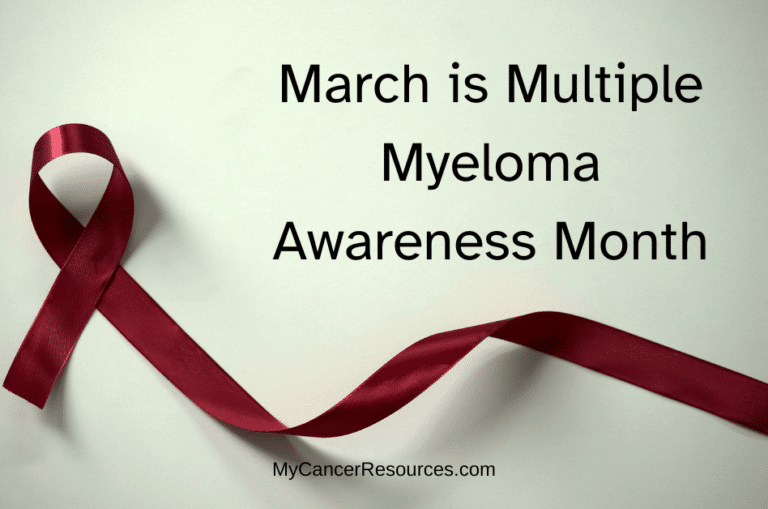
March is Multiple Myeloma Awareness Month. This rare type of blood cancer, also called Kahler’s disease, starts in the plasma cells of the bone marrow. This is a great time to learn more about multiple myeloma, who tends to develop this cancer, how it’s diagnosed and treated.
Since it’s rare, it’s important to raise awareness of multiple myeloma. If you have certain risk factors, it’s important to learn about the symptoms of multiple myeloma so that if you are showing signs, a visit to healthcare providers can check your blood work.
Just like with other cancers, early diagnosis of multiple myeloma can lead to better outcomes.
Understanding Myeloma
Myeloma is a cancer of the plasma cells in the bone marrow. Plasma cells are white blood cells that create antibodies that help protect us from infections from bacteria and viruses.
When myeloma cancer cells develop and grow in the bone marrow, they form tumors. These tumors crowd out the normal stem cells that make other white blood cells, platelets and red blood cells. This keeps the bone marrow from making enough healthy blood cells.
If left untreated, the cancerous cells can increase bone breakdown and also prevent new bone cell production. This increases the risk of bone pain and broken bones.
Since healthy white cells aren’t able to grow because the cancer cells have taken over the bone marrow, the immune system can’t protect against infection.
This can also lead to high levels of protein and cancer in both the urine and blood, both of which can lead to kidney damage.
Myeloma is often called multiple myeloma because about 90% of people have multiple tumors in their bones at the time of diagnosis. Often these tumors are found in the pelvis, ribs, spine and skull.
Multiple Myeloma Statistics
Multiple myeloma is the second most common blood cancer in the world.
Approximately 160,000 new cancer cases are diagnosed each year worldwide.
In the U.S., an estimated 157,561 people are living with or are in remission from myeloma.
According to the American Cancer Society, in 2024, around 35,780 new cases will be diagnosed in the U.S., and around 12,540 deaths from multiple myeloma are expected.
It is 1.5 times more common in men than in women, so the average lifetime risk of a man in the United States developing multiple myeloma is 1 in 103. For women, it’s 1 in 131.
Six states have higher multiple myeloma rates than the national average: Florida, Kentucky, Louisiana, Mississippi, New York and Texas.
African Americans have twice the incidence of myeloma as white Americans.
Multiple myeloma is most often diagnosed in 65-74 year olds.
With the development of new treatment options, the five-year survival rates of multiple myeloma have increased each year since data was first made available in 1975.
Risk Factors for Myeloma
Some risk factors for developing multiple myeloma in addition to being assigned male at birth, being African American, and over age 50 include:
- Having a blood protein condition called MGUS: monocolonal gammopathy of unknown significance
- Being obese
- Having chronic immunodeficiency
- Some occupations, like firefighters have a much higher risk of developing cancers, including multiple myeloma
- Exposure to chemicals and toxins may also increase your risk
- Family members who have had a multiple myeloma cancer diagnosis
Signs and Symptoms of Multiple Myeloma
Sometimes there are no symptoms of multiple myeloma. This happens with something called smoldering multiple myeloma. The cancer may be found when a blood or urine test is done for another health issue.
The most common symptoms of the disease include:
- Bone pain, weakness or breaks, especially in the back or ribs
- Low blood counts, like anemia
- High levels of calcium
- Weakness or fatigue
- Frequent infections
- Kidney problems
- Fever with no known cause
- Easy bleeding or bruising
- Frequent urination
- Confusion and dizziness
How Myeloma is Diagnosed
Often, blood test or urine test results alert healthcare professionals that something is off. A myeloma diagnosis is confirmed only with a bone marrow aspiration and bone marrow biopsy.
A bone marrow aspiration uses a small needle to withdraw liquid bone marrow, typically from a spot in the back of the hipbone. This liquid is examined underneath a microscope to look for malignant plasma cells.
A bone marrow biopsy is often done at the same time as an aspiration. This is where a small piece of bone tissue is removed from the same location, along with the marrow inside the bone.
Both the bone and the marrow are examined for the presence of cancer cells.
Multiple Myeloma Treatment
Myeloma treatment has dramatically improved over the last couple of decades. And new therapies are approved every year.
This means that myeloma is often considered and managed as a chronic disease.
Chemotherapy, radiation, immunotherapy and stem cell transplants are the primary ways in which multiple myeloma is treated.
These treatments have led to better survival rates and longer periods of remission.
Chemotherapy uses specific drugs (often multiple drugs together for multiple myeloma) to target and kill fast growing cells, like cancer cells.
Radiation therapy uses beams of radiation to target tumors.
A stem cell transplant involves using one’s own healthy bone marrow or stem cells to replace diseased marrow or stem cells. This process is discussed in greater detail in another article.
Immunotherapy is the name of a type of treatment that uses one’s own immune system to fight cancer. These treatments either boost the immune system to improve the way it fights the cancer cells, or change how the immune system works and interacts with cancer cells.
Some types of immunotherapy used for multiple myeloma include CAR T-cell therapy, which is where t cells (which help protect the body) are removed from the body.
Next they are re-engineered in a lab to alter certain receptors on the cell.
From there, millions of these cells are developed and then they are infused back into the patient.
Antibodies are another form of treatment.
One example is bispecific antibodies work by both boosting the immune system and target certain proteins on the myeloma cells.
This draws the myeloma cell to the T-cell, which causes the cancerous cell to self-destruct.
As clinical research, including clinical trials continue to expand and develop new treatments for multiple myeloma, we can look forward to even greater survival rates, and hopefully improve the quality of life for myeloma patients at the same time.
Conclusion
Multiple myeloma awareness month is a great time to learn about this relatively uncommon cancer, it’s risk factors and how it’s diagnosed and treated.
It’s important to educate community members about this disease, especially African American communities, who are at greater risk.
Thankfully, this is a pretty rare cancer, for which treatment is often successful. But early diagnosis is even better for improving success rates.
Further research is always needed, especially for cancers that are less common. Improving cancer treatment options to be easier on patients, cause fewer side effects and be even more effective is critical.



